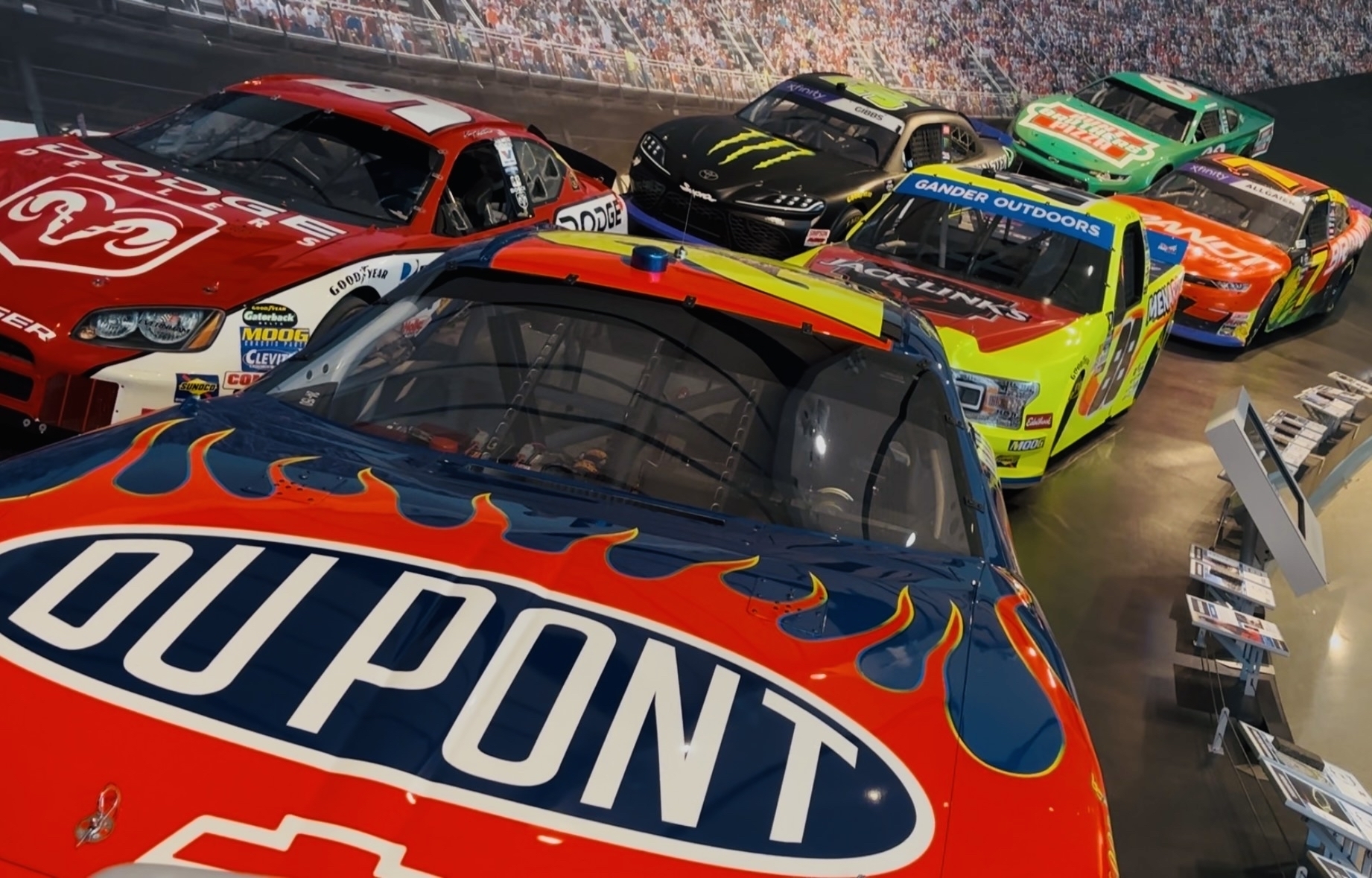Hershel McGriff’s Mexico Magic
by Tom Jensen June 12, 2025
In 1950, Hall of Famer Hershel McGriff drove a borrowed Oldsmobile from Oregon to Mexico, where he won the inaugural Carrera Panamericana.
Editor’s note: With NASCAR racing in Mexico this weekend, Curators’ Corner takes you back 75 years to the first time NASCAR Hall of Famers raced south of the border.
In early 1950, the Mexican portion of the Pan American Highway linking Central and North America was completed.
To both celebrate the achievement and promote the new highway, which ran more than 1,900 miles north to south, the Mexican government decided to stage a road race called the Carrera Panamericana.

Hershel McGriff looks on as his crew goes to work on his Oldsmobile in the first Carrera Panamericana in 1950. NASCAR Hall of Fame Collection, Gift of Violet Parks
The inaugural race drew worldwide attention and competitors from across the globe. All told, 132 cars entered the first race, including 58 from the United States, along with nine women. There were racers from NASCAR, Formula One, sports car racing, rallying, Indianapolis style open-wheelers and many other racing disciplines.
The president of Mexico even entered a car, which was driven by an Army officer who survived a pair of rollover crashes and became a national hero for his bravery in competition.

Curtis Turner (right) helps William H. G. France load up their team’s Nash Ambassador sedan. NASCAR Hall of Fame Collection, Gift of Violet Parks
There were no rules or classes, so every team competed against each other in a style of racing referred to as “run what you brung.” And while most of the cars were large American coupes and sedans, there were also nimble European sports cars from Porsche, Jaguar, Delahaye and other marques. This was not a NASCAR-sanctioned event, but a wide-open race that attracted all manner of competitors.

The course featured a number of terrain changes, from sea level to high in the mountains. NASCAR Hall of Fame Collection, Gift of Violet Parks
NASCAR, which was barely two years old at the time, was well represented by Hall of Famers. NASCAR founder William H.G. France (2010) and Curtis Turner (2016) who teamed up to co-drove a Nash, while car owner Raymond Parks (2017) and driver Red Byron (2018) fielded a Lincoln, as did brothers Tim (2015) and Fonty Flock.

This Ford, driven by Ewald Nieders and Max Diener was one of many cars that crashed out of the race. NASCAR Hall of Fame Collection, Gift of Violet Parks
Hershel McGriff (2023) drove a borrowed Oldsmobile from his Oregon home to the Texas-Mexico border for the start of the race. Also competing was Johnny Mantz, who later that year would win the inaugural Southern 500 at Darlington Raceway.
The race was run in nine stages over five days, starting on May 5, 1950. Large sections of the course featured smooth, freshly paved asphalt, but there were other parts of the course that were narrow and unpaved, little more than cart paths. The course also snaked through crowded cities that were difficult to navigate, especially for the big American cars that dominated the entry list.

Many of the competitors ran into mechanic woes along the challenging mountainous course. NASCAR Hall of Fame Collection, Gift of Violet Parks
The course ran in elevations that varied from sea level to more than 10,000 feet up into the mountains, making engine tuning complicated, because carburetors had to be adjusted for thin air at high altitude. And there were plenty of complaints about the poor quality of the gasoline that the Mexican government required all racers to purchase.
Worse yet, the more than 1,900-mile course was fraught with danger. There were steep drop-offs and no guardrails. Spectators lined both sides of the road along the way, even though there was nothing to protect them should one of the competitors lose control of their cars.

Joel Thorne and his Cadillac didn’t get very far in the race before meeting a bad ending. NASCAR Hall of Fame Collection, Gift of Violet Parks
Attrition was brutal as well. In 1950, only 47 of the 132 entrants were classified as having finished the event. For most of the NASCAR contingent, the results were not good.
Car owner Parks was robbed of $2,000 and his driver, Byron passed out at the wheel and crashed, while the Flock brothers completed only four of nine stages.

Some of the accidents along the course held up traffic. NASCAR Hall of Fame Collection, Gift of Violet Parks
On a much happier note, the race victory went to Hershel McGriff, who at the time was just 22 years old. McGriff completed the 1,907-mile course in a time of 27 hours, 34 minutes and 25 seconds, an average speed of 78.75 miles per hour in his neighbor’s borrowed Oldsmobile.
And here’s an odd bit of trivia: In the augural Carrera Panamericana in 1950, Hershel McGriff won and Johnny Mantz finished ninth. In the inaugural Southern 500 later that same year, Mantz won and McGriff finished ninth.

Hershel McGriff receives his trophy and a handshake after his historic victory. NASCAR Hall of Fame Collection, Gift of Violet Parks
Ultimately, the Carrera Panamericana lasted just five years, from 1950 to ’54. Some say the plug was pulled because of the extreme danger – nearly 30 people died in five years – while others have suggested that closing public roads to conduct a weeklong auto race was an untenable hardship.
Whatever the explanation, this unusual road race definitely earned its spot in the auto racing history books.
Plan your visit to the NASCAR Hall of Fame and purchase tickets by visiting nascarhall.com/tickets.













